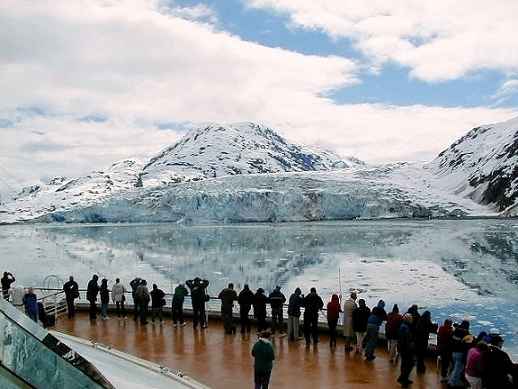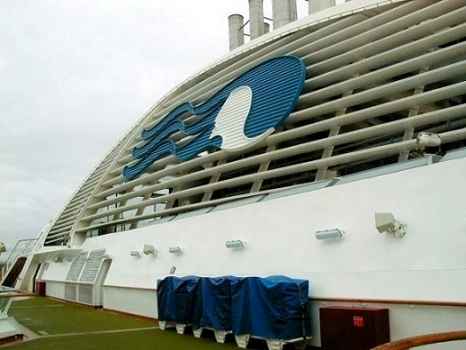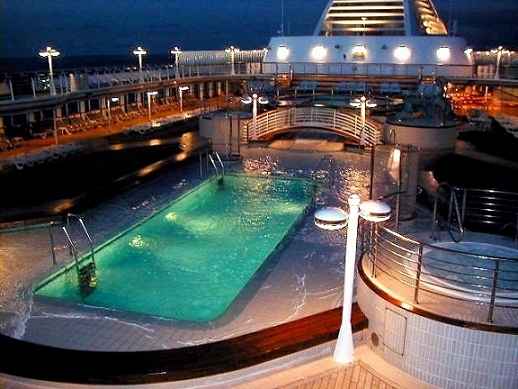Tips and Suggestions for Cruising Alaska

|
All of these tips and suggestions are based on my experiences on the 12-day Heart of Alaska Cruisetour from Princess. Your experiences may vary. The tips should be taken as advice only. I accept no responsibility for bad advice.
I've tried to separate the suggestions according to whether they are specific to Alaska in general, specific to Princess cruises and cruise tours, or just general advice for traveling by ship.

|
Alaska Specific Tips
- Bring warm clothing.
- Windy and rainy conditions are not uncommon in Alaska throughout the cruise season. Temperatures may drop into the 30s (F), or even lower early or late in the season. If you want to spend time on deck while the ship is under way, the temperature can feel much colder, especially if you are near the bow. Ski masks, heavy gloves, scarves, and heavy parkas were appropriate at times on my cruise.
- Bring lightweight clothing.
- Warm and dry weather is possible, especially in the interior of Alaska (Fairbanks, for example). Temperatures may approach 100 in July and August, and will frequently get into the 70s throughoyt the tourist season.
- Bring rain gear.
- You will almost certainly need it at least once. Be prepared for lots of rain, fog, and low overcast, especially during the cruise portion of your vacation. This whole southeast Alaska region is some of the wettest in North America, and it's unlikely that you won't experience precipitation. Those gorgeous pictures you see in the various cruise brochures are by no means typical of the "real Alaska" - the "real Alaska" most people experience on a cruise is considerably less sunny.
- Bring your camera or camcorder and lots of film.
- A telephoto lens or a built-in zoom is strongly recommended. If you have to make a choice between one or the other, I think a camera is more generally useful than a camcorder when visiting Alaska unless you know how to provide good running commentary for video. Still images seem to help capture the essence of Alaska better than video.
- Don't bring a camera tripod.
- You won't have much opportunity to use it since you'll usually be on a moving platform, and will likely have too little time to bother setting up a tripod when you aren't. The ship may seem like a reasonable place to set up a tripod, but buffeting from wind will usually render a tripod useless. Ignore this advice if you are making a self-guided visit to Alaska, or are taking a tour explicitly designed for photography.
- Know your camera.
- Know how to use the features of the camera you will be using - know them instinctively, and be able to use them quickly. Oftentimes you will only have a few seconds in which to set up your camera, aim, focus and shoot. The quicker you can do that the more likely you are to catch just the right image. If you have a heavy telephoto lens, you should learn how to keep it steady without the aid of a tripod. If you want to take pictures while on deck, learn how to keep the camera steady in a buffeting wind. A tripod won't help here, but the ship's rails can be quite useful for steadying the camera.
- Use the high quality setting on digital cameras.
- Photographically, the biggest mistake I made was using the lowest quality setting on my camera. While this allowed me to place many more images on each SmartMedia card, it significantly reduced my options for post-voyage processing of the images. In particular, attempts to blowup images that were too small met with minimal success. It would have been better to take photos using a higher-quality setting.
- Learn to deal with glass between your camera and your subject.
- Accept the fact that you will be behind glass much of the time on any organized tour of Alaska. Make the most of the photo opportunities you do have, and try to make do with the distortions of glass when your only other choice is to pass up a great shot - sometimes, you can get surprisingly good images as the glass can sometimes lend something positive to the photo. You may not always see that positive immediately, but can be surprised after processing.
- Bring binoculars.
- You will need them to spot most wildlife. Most people on our cruise seemed to have 7x35 binoculars, but found them marginally adequate. I had 7x50 power glasses, and found them to be quite adequate, though there were a few occasions where even more powerful glasses would have been appropriate. If possible, make sure you are using a light-weight set - lugging around a heavy pair of binoculars can be cumbersome.
- Bring mosquito repellent.
- If you are traveling in May, you may be able to get by without it, but after May, you will very likely need it.
- Choose your travel dates wisely.
- The tourism season in Alaska is May to September. The best time to go is strictly an individual consideration, but here are my suggestions:
- For maximum daylight hours, go in May, June, or July. In Fairbanks, there are 24 hours of daylight from late May to late June.
- For the warmest days, travel in July or August. Note that it can get quite hot in Fairbanks at this time of year. Warmth is also relative, as summer temperatures in the 50s are common in southeast Alaska.
- For the best chance at seeing the northern lights (aurora borealis), sail in September. Even so, you probably won't see them - the northern lights are primarily a winter phenomenon when the nights are darkest and longest - if you really want to see the aurora, head north in the winter months.
- To avoid mosquitoes, try May (but be prepared anyway).
- For the best cruise prices, you can't beat May and September.
- To have a good chance at seeing bears at fairly close range, go during the salmon spawning season - I believe July, August, and September are the right times.
- Fishing is good throughout the tourist season, but be sure to go when the fish you want are running.
- For the smallest crowds, May and September are probably best.
- I don't believe there is a best time for avoiding rain and fog, but May and June are supposed to be the best weather months in Glacier Bay.
- Denali National Park is very brown in May and June, extremely green in July and August, and very colorful (primarily red and yellow) in September.
- Snow-topped mountains may be seen any time, but the best time is May.
Seekers of the real Alaska will also make arrangements to visit the Great Land during the winter. Activities are much more limited during this time as most tourist operations only run from May through September. However, there are always places to go and things to do, even deep in the winter - even a few tourist operations run year-round. I've been told that March, in particular, is supposed to be one of the best times for a winter visit, as the long night ends and Alaskans start getting just a wee bit stir-crazy (outhouse races anyone?). March is also when the Iditarod is run. Be prepared to change plans on short notice during the winter as travel can be extremely difficult throughout Alaska.
- Keep your expectations realistic.
- Tourism brochures, TV documentaries, movies, and more often give the Alaskan-bound tourist an unrealistic sense of what they will encounter while in Alaska. No doubt, Alaska is spectacular with landscapes that can leave one feeling totally overwhelmed, but the parts of Alaska visited most by tourists are also the parts most subject to limited visibility from rain, fog, and smoke from forest fires. A lot of people who visit Alaska will complain that they were unable to see anything due to bad conditions, that they failed to see the "real Alaska". Like it or not, though, seeing the "real Alaska" means dealing with its climate, and most people would not consider Alaska's climate pleasant. I came to Alaska knowing all this, and as someone who actually enjoys foul weather, but still I found reason to complain at times.
Likewise with expectations about wildlife. Alaska is mostly wilderness - it is not a zoo with animals on display around every corner. The animals don't wander out to see what's happening when a cruise ship, train, or bus passes nearby. Quite the opposite - many will leave the area at any sign of man or his machines. You will almost certainly see some wildlife while in Alaska - whales, bears, eagles, caribou, moose, otters, seals, and more - and a great deal of it. But, its abundance is not as evident to the human senses as you might believe. Furthermore, cruise ships are not often close enough to shore to see wildlife with the unaided human eye - both strong binoculars and a great deal of patient observing is necessary. Photo opportunities are far and few between, so make the most of those you do have - a good zoomable telephoto lens lightweight enough to be used without a tripod could be of tremendous help here. If possible, try to learn how to best search for wildlife before you get on the ship - know what animals you can expect to see, know what types of habitat they prefer, and learn how to identify them when their natural camouflage makes them nearly impossible to see. It's not difficult to learn the needed tricks - you can learn most of what you need from listening to the ship's naturalist - but by the time you do learn it, your cruise will be nearly over. A couple of good Alaskan wildlife books could go a long way to helping you find wildlife once you're in Alaska. Another good technique is to make friends with someone who already knows the tricks - hang out on the ship's decks and you will soon spot these folks - and spend as much time as you can with that person.

|
Princess Specific Tips
The tips in this section apply primarily to Princess cruises. They may or may not be applicable to other cruise lines.
- There's no need to overdress.
- If you don't feel like buying or renting a tuxedo or evening gown for the formal nights on ship, don't bother. Do wear something reasonably nice if you don't want to be too much out of place, but you won't need a tux or gown to fit in.
- Bring an extension cord.
- If you have more than one item that may need to be plugged-in while in your stateroom, you will probably need it. Our stateroom had only one outlet.
- Be prepared for lost luggage.
- Throughout your cruise and land tour, Princess will take responsibility for getting your luggage from one location to another. However, be aware that they can and do lose luggage occasionally - we heard stories of lost luggage at every destination where luggage was moved. Princess will assist in buying clothes and necessities if the fault might be theirs, but you really don't want the hassle of lost luggage. Personally, I think most of the lost luggage problems may be attributable to improper tagging of bags - each time your luggage is moved, it must have the appropriate tags so the luggage handlers know where to send it. Make sure that your baggage is always marked with the appropriate tags, and make sure each bag is marked on the outside with your name, address, ship name, destination, and dates.
- Don't worry about packing light.
- You won't have to handle your bags very often. Storage space in the staterooms is ample despite the low square footage.
- Try to spend two nights at each location on land tours.
- If you spend only one night at a land location, you will find yourself rushed through the various sights, and will feel as though you didn't get an adequate chance to explore. Better yet, rent a car or make other travel arrangements, and conduct your own land-tour in your own time. Alaska is tougher to get around by car than most places due to its enormous size and lack of roads, but you can drive to most of the major tourism locations. Bush pilots will be happy to fly you most anywhere in the state inaccessible by road (at a price, of course).
- Pig out at dinner.
- Don't be afraid to ask for items not on the menu, or for seconds of any item, in the dining room. The dining room staff wants you to be happy (happy travelers generally make bigger tippers), and will go out of their way to see that you get what you want.
- Expect bad coffee.
- If you like good coffee, consider bringing your own coffee and coffee maker with you.

|
General Cruising Tips
- Be prepared for seasickness.
- It can strike, even on the mostly calm waters of an Inside Passage cruise.
- Don't overdo the shore excursions.
- If you don't plan on physically being on the ground for at least 10 hours, take no more than one shore excursion. Likewise, you probably shouldn't take more than two excursions if you are off ship for more than 10 hours. Allow yourself plenty of time to explore on your own, do some shopping, or just relax somewhere. Taking too many excursions in a port will likely leave you feeling as though you missed something. Tours often take longer than scheduled, so allow at least 1-1/2 hours between excursions if taking more than one and you need a meal break between. Allow more time if you don't plan on eating on the ship. Trying to squeeze too many excursions into the time at each port was probably the biggest mistake we made on our cruise.
- Seek out excursions not advertised by your cruise line.
- You are not limited in your choices of excursions to just those offered by your cruise line. Often, you can find something that will be much more to your liking than the standard options. Get on the web or contact your travel agent and do some research, and you might find something that will be far more memorable than the standard tourist fare. My own experience taking a hot air balloon ride in Fairbanks was a perfect example of this - it was the most memorable experience of my trip. Going with an operation not affiliated with the major cruise lines probably also helps to pump more money into the local economies - the cruise lines surely get a significant cut of the revenues generated by the approved excursions.
- Use a travel agent whom you know and trust to book your cruise.
- Travel agents can make a huge difference in how well prepared you are before going on the cruise, as we found in discussions with various people we met on ours. It's especially helpful to find an agent who has already taken cruises with your choice of cruise lines, and better yet to find one who has taken the same cruise you want to take. Our own agent, Susan Smith of Paducah, Kentucky was wonderful, and enormously helpful in helping us to first select a cruise, then in getting ready for it.
- Book early.
- Most cruise lines, including Princess, offer significant savings to people who book early. In the case of Princess, Alaska cruises need to be booked by mid-February to obtain the early booking savings. Booking an Alaska cruise in particular probably should be done even earlier than that - we booked in late December, and had to choose a slightly different cruise when our first choice was already fully booked.
- Book your shore excursions early.
- Some cruise lines, including Princess, allow you to book your shore excursions some time before your cruise begins. Take advantage of this to avoid long lines and disappointments. It is especially important to do so with excursions that have strictly limited participation, such as those that involve flightseeing.
- Most cruise lines, including Princess, offer significant savings to people who book early. In the case of Princess, Alaska cruises need to be booked by mid-February to obtain the early booking savings. Booking an Alaska cruise in particular probably should be done even earlier than that - we booked in late December, and had to choose a slightly different cruise when our first choice was already fully booked.
- Upgrade your stateroom intelligently.
- The vast majority of staterooms are nearly identical in size and amenities, but the pricing can vary significantly. The chief reason for upgrading is to get an outside stateroom (preferably with a balcony), or, for those with more money than they need, one of the suites. It may also be worthwhile to upgrade to get a room that experiences less motion - in general, the least motion is experienced in inside staterooms near the center of the ship. Generally, the lower decks experience less motion than do the upper decks. Mobility problems may also drive your decision to upgrade to a different location. Being near the elevators is convenient, and being on a deck where the elevators and stairs won't be needed often (especially during the emergency drill) may help to make your decision.
- Keep your stateroom neat.
- If the steward has to move things around so he can do his job, you may have trouble finding your stuff again when you return.